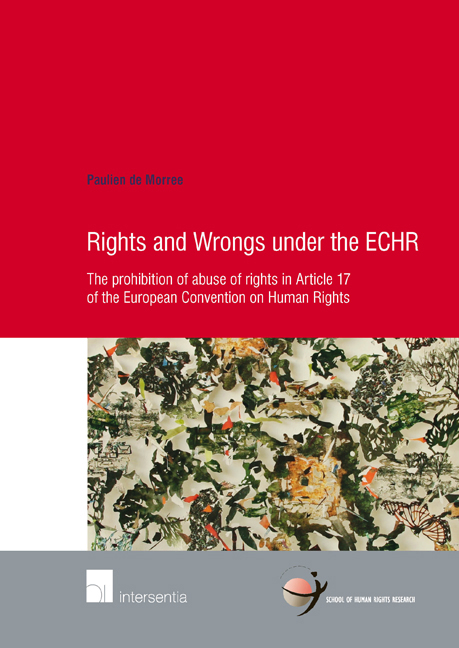 Rights and Wrongs under the ECHR
Rights and Wrongs under the ECHR Book contents
- Frontmatter
- Acknowledgements
- Contents
- List of Abbreviations
- Chapter 1 Introduction
- Chapter 2 The Creation of the European Convention on Human Rights
- Chapter 3 The Strasbourg Case Law on Article 17 ECHR
- Chapter 4 The Interpretation of Article 17 Echr in Legal Doctrine
- Chapter 5 Other Abuse Clauses in Human Rights Law
- Chapter 6 The Concept of Abuse of Rights
- Chapter 7 The Concept of Militant Democracy
- Chapter 8 The German ‘Wehrhafte Demokratie’
- Chapter 9 Militant Democracy in the Context of the ECHR
- Chapter 10 Conclusions
- Bibliography
- Table of Cases
- Samenvatting
- Curriculum Vitae
- School of Human Rights Research Series
Chapter 2 - The Creation of the European Convention on Human Rights
Published online by Cambridge University Press: 12 December 2017
- Frontmatter
- Acknowledgements
- Contents
- List of Abbreviations
- Chapter 1 Introduction
- Chapter 2 The Creation of the European Convention on Human Rights
- Chapter 3 The Strasbourg Case Law on Article 17 ECHR
- Chapter 4 The Interpretation of Article 17 Echr in Legal Doctrine
- Chapter 5 Other Abuse Clauses in Human Rights Law
- Chapter 6 The Concept of Abuse of Rights
- Chapter 7 The Concept of Militant Democracy
- Chapter 8 The German ‘Wehrhafte Demokratie’
- Chapter 9 Militant Democracy in the Context of the ECHR
- Chapter 10 Conclusions
- Bibliography
- Table of Cases
- Samenvatting
- Curriculum Vitae
- School of Human Rights Research Series
Summary
INTRODUCTION
The prohibition of abuse of rights in Article 17 ECHR is very much a product of its time. Before the second half of the 20th century, such a formula had not been recognised in any of the principal human rights texts. But the historical context in which the Convention came into being – just after the Second World War – was crucial for the creation of the abuse clause. This chapter explores what motivated the drafters to include Article 17 ECHR in the Convention. It will move through the different stages of the drafting of the Convention, from the first steps in creating a European human rights treaty by the European Movement in 1948 to the final signing of the Convention by the Member States of the Council of Europe in 1950. The drafting of the Convention, even though it took only roughly two years, was a complex and arduous process. This chapter will not elaborate at length on this process, but instead focuses on aspects of the drafting of the Convention that form the background of the prohibition of abuse of rights in Article 17 ECHR.
FIRST STEPS BY THE EUROPEAN MOVEMENT
The ECHR was developed during the turbulent first years following the Second World War. On the one hand, the atrocities committed by the Nazi regime had shaken up the international community and through international cooperation European democracies wanted to prevent such a tragedy from ever happening again. On the other hand, the immediate post-war period was dominated by rising tensions between ‘East’ and ‘West’ and the Soviet Union under Stalin was considered a severe and immediate threat to Western European democracies. In the midst of all of this, the first steps towards a European human rights convention were taken by the International Committee of the Movement of European Unity, or the ‘European Movement’.
During the first half of 1949 the European Movement started to prepare a draft European human rights convention. Set against the experience of totalitarianism during the Second World War, they attached great significance to democracy. They believed respect for human rights and a democratic form of government to go hand in hand. The Convention to be drafted would therefore embody Europe's ‘ardent belief in human rights and democracy’.
- Type
- Chapter
- Information
- Rights and Wrongs under the ECHRThe prohibition of abuse of rights in Article 17 of the European Convention on Human Rights, pp. 15 - 22Publisher: IntersentiaPrint publication year: 2016
- 4
- Cited by


